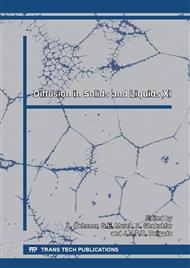p.59
p.65
p.71
p.77
p.83
p.89
p.95
p.99
p.104
High Temperature Oxidation Behavior of High Strength Steel Plates
Abstract:
Three kinds of high-strength steel plates containing (less than 0.07%, or 0.024%, or 0.057%)-Si were oxidized at 700-900 °C isothermally and cyclically in atmospheric air, and their oxidation behavior was compared. The composition of the steels significantly affected the scaling rates, thickness, and adherence of the formed scales. The most important element in terms of oxidation was Si because Si affected the oxidation rates and scale adherence much. Silicon formed quite slowly a growing SiO2–containing scale around the scale/matrix interface. In the Si-deficient steel, quite thick oxide scales formed, and their adherence was poor. An optimum amount of Si was necessary in order to decrease the oxidation rate, and improve the scale adherence.
Info:
Periodical:
Pages:
83-88
Citation:
Online since:
July 2016
Authors:
Keywords:
Price:
Сopyright:
© 2016 Trans Tech Publications Ltd. All Rights Reserved
Share:
Citation:


